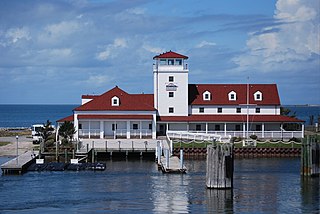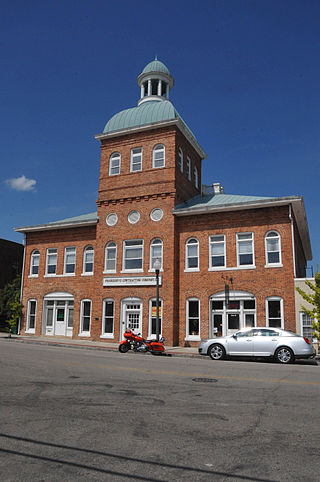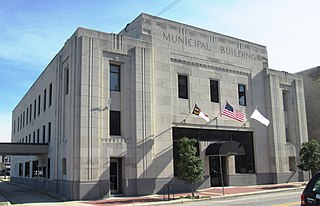
The La Grange Historic District is a national historic district located in La Grange, North Carolina, United States. The district, originally encompassing 225 buildings and 1 structure, includes the historic commercial, residential, and industrial center of La Grange. The buildings include notable examples of Gothic Revival, Queen Anne and Bungalow/American Craftsman styles of architecture and date between the 1850s and the 1940s. Located in the district is the separately listed La Grange Presbyterian Church. Other notable buildings include the Sutton-Kinsey House, Walter Pace House, Sutton-Fields House, Colonel A. C. Davis House (1887), and the Rouse Banking Company Building (1908). The historic district was added to the National Register of Historic Places in May 2000.

Burlington Historic District is a national historic district located at Burlington, Mineral County, West Virginia. The district includes 45 contributing buildings and 2 contributing sites in the central business district and surrounding residential areas of Burlington. The district includes notable examples of vernacular interpretations of the Greek Revival and Queen Anne styles.

The Manheim Borough Historic District is a national historic district that is located in Manheim, Lancaster County, Pennsylvania.

Halifax Historic District is a national historic district located at Halifax, Halifax County, North Carolina, US that was listed on the National Register of Historic Places in 1970. It includes several buildings that are individually listed on the National Register. Halifax was the site of the signing of the Halifax Resolves on April 12, 1776, a set of resolutions of the North Carolina Provincial Congress which led to the United States Declaration of Independence gaining the support of North Carolina's delegates to the Second Continental Congress in that year.

Washington Historic District is a national historic district located at Washington, Beaufort County, North Carolina. It encompasses 512 contributing buildings and one contributing structure in the town of Washington. They include a variety of institutional, commercial, and residential buildings primarily dating from the late 19th and early 20th centuries. Notable buildings include the Beaufort County Courthouse, Havens and Fowle warehouses, Mayo Law Office, Marsh House, Myers House, Hyatt House, Griffin House, Rodman House, Elmwood, Firehouse and City Hall, Post Office and Federal Courthouse (1913), railroad station, Presbyterian church, Saint Peter's Episcopal Church, First Methodist Church (1899), Singleton Primitive Baptist Church, Blount-Bragaw Building (1901-1904), Minor House, and George T. Leach House.

Rocky Mount Central City Historic District is a national historic district located at Rocky Mount, Edgecombe County and Nash County, North Carolina. The district encompasses 166 contributing buildings in central Rocky Mount. It includes a variety of industrial, commercial, residential, and institutional buildings dating from the late-19th through mid-20th centuries. Notable buildings include the Firestation No. 2 (1924), Union Bus Station (1951), the Railway Express Agency Building, Memorial Hospital (1937), Church of the Good Shepherd (1877), Atlantic Coastline Railroad Station (1903-1916), Imperial Tobacco Company Processing Plant (1903-1923), S. H. Kress and Company, Belk-Tyler, Grand Theater, Manhattan Theater, Holy Hope Episcopal Church (1910s), and Summerlin House (1895).

Waughtown–Belview Historic District is a national historic district located at Winston-Salem, Forsyth County, North Carolina. The district encompasses 1,137 contributing buildings, 1 contributing site, and 1 contributing object in a largely residential section of Winston-Salem. The buildings date from about 1834 to 1955, and include notable examples of Greek Revival, Colonial Revival, Queen Anne, and Bungalow / American Craftsman style architecture. Located in the district is the separately listed Shell Service Station. Other notable resources include the Clodfelter House, Fiddler House, Nissen Wagon Works smokestack, Triangle Body Works, Waughtown Baptist Church (1919), Waughtown Presbyterian Church (1914), Southside Christian Church, and Waughtown Cemetery.

Fisher Park Historic District is a national historic district in the Fisher Park neighborhood, Greensboro, Guilford County, North Carolina. The district encompasses 541 contributing buildings, 2 contributing sites, and 44 contributing structures in a predominantly residential section of Greensboro. The houses were largely built between the 1900s and 1930s and include notable examples of Queen Anne, Colonial Revival, Gothic Revival, American Foursquare, and Bungalow / American Craftsman-style architecture. Located in the district are the separately listed Dixon-Leftwich-Murphy House, John Marion Galloway House, Julian Price House, and Latham-Baker House. Other notable buildings include the First Presbyterian Church (1928), Holy Trinity Episcopal Church (1922), Gant-McAlister House, and A.J. Schlosser House.

Scotland Neck Historic District is a national historic district located at Scotland Neck, Halifax County, North Carolina. It encompasses 249 contributing buildings and 1 contributing object in the central business district and surrounding residential sections of the town of Scotland Neck. The district includes notable examples of Greek Revival and Gothic Revival style architecture. Located in the district is the separately listed Hoffman-Bowers-Josey-Riddick House. Other notable buildings include the Fenner-Shields-Lamb House (1827); D. Edmondson Building, E. T. Whitehead drug store ; Scotland Neck Bank (1914); Baptist Church (1917); Trinity Episcopal Church (1924); and town hall and fire station (1939), brick gymnasium and vocational building (1940), and one-story, elongated brick multiple housing unit (1943) built by the Works Progress Administration. The latter building was utilized as a prisoner-of-war camp during World War II.

Ocracoke Historic District is a national historic district located at Ocracoke, Hyde County, North Carolina. The district encompasses 228 contributing buildings, 15 contributing sites, and 4 contributing structures on Ocracoke Island in Ocracoke village. The district includes notable examples of Late Victorian, Shingle Style, Bungalow / American Craftsman, and Coastal Cottage style architecture dating from about 1823 to 1959. A number of the houses were constructed from salvaged ship timbers. Located in the district is the Ocracoke Light Station. Other notable contributing resources include the Simon and Louisa Howard House, the Kugler Cottage, Tolson-Rondthaler House, Simon and Sarah Garrish House (1888), Spencer Bungalow (1937), Benjamin Fulcher House, William Charles Thomas House (1899), Styron Store (1920s), Willis Store and Fish House, Coast Guard Station and British Cemetery, the United Methodist Church, Assembly of God Church, the Island Inn (1901), and Berkley Manor and Berkley Castle.

Downtown Sanford Historic District is a national historic district located at Sanford, Lee County, North Carolina. It encompasses 53 contributing buildings in the central business district of Sanford. The district includes notable examples of Colonial Revival, Tudor Revival and Art Deco style architecture, with buildings largely dated between about 1895 to 1930. Located in the district are the separately listed Railroad House and Temple Theatre. Other notable buildings include the Sanford Buggy Company, McCracken Building, Passenger Depot, City Hall, Coca-Cola Bottling Company, Masonic Lodge, Makepeace Building (1924), Wilrick Hotel (1925), Bowers Building, Cole Pontiac Building, Hubbards Shoe Store (1926), Carolina Hotel (1930), and former U. S. Post Office.

Star Historic District is a national historic district located at Star, Montgomery County, North Carolina. The district encompasses 85 contributing buildings, 2 contributing sites, and 3 contributing structures in the town of Star. The district developed between 1896 and 1963 and includes notable examples of Queen Anne, Romanesque Revival, Colonial Revival, and American Craftsman style architecture. Notable contributing resources include the Leach-Allen House and Wright Dairy, Leach Cemetery (1859), Star Railroad Depot, Bank of Star, Star Hotel (1896), Allen Building, Pontiac Dealership, Nalls Watch Repair Building/C. V. Richardson Hosiery/Star Town Hall, Star Methodist Church, and Star Presbyterian Church (1953-1958).

Aberdeen Historic District is a national historic district located at Aberdeen, Moore County, North Carolina. The district encompasses 101 contributing buildings, 1 contributing site, and 2 contributing structures in the town of Aberdeen. It was developed between 1880 and 1940 and includes notable examples of Queen Anne, Classical Revival, and Bungalow / American Craftsman style architecture. Located in the district is the separately listed John Blue House. Other notable buildings include the Postmaster's House, Aberdeen and Asheboro Railroad Building, Page Memorial Library (1907), (former) Union Station (1906), Aberdeen and Rockfish Railroad Building (1904), Bank of Aberdeen, Page Memorial United Methodist Church (1913), (former) Bethesda Presbyterian Church (1906-1907), and Faith Presbyterian Church.

Jackson Historic District is a national historic district located at Jackson, Northampton County, North Carolina. The district encompasses 168 contributing buildings, 2 contributing sites, 1 contributing structure, and 2 contributing objects in the central business district and surrounding residential sections of Jackson. The district developed between about 1825 and 1953 and includes notable examples of Federal and Greek Revival style architecture. Located in the district are the separately listed Amis-Bragg House, Church of the Saviour and Cemetery, and Northampton County Courthouse Square. Other notable contributing resources include Lewis Drug Store (1930), Kennedy's Five Cents to Five Dollars Store, Bank of Northampton (1928), Bowers Hardware Store, Atlas Oil Company Building, Farmer's Cotton Gin Complex, Faison House, Saint Catherine's Hall (1848), Judge Robert Peebles House (1890s), Selden-Boone House, Jackson Baptist Church (1881), and Jackson United Methodist Church (1937).
Burgaw Historic District is a national historic district located at Burgaw, Pender County, North Carolina. The district encompasses 130 contributing buildings, 1 contributing structure, and 1 contributing object in the central business district and surrounding residential sections of Burgaw. The district developed from the mid-19th to mid-20th century, and includes notable examples of Gothic Revival and Queen Anne style architecture. Located in the district are the separately listed Burgaw Depot and Pender County Courthouse. Other notable contributing buildings include the M. M. Moore House, Murphy-Sasser House, Dr. H. B. Thomas House, Burton-Noel House (1917), Burgaw Presbyterian Church, Macedonia African Methodist Episcopal (AME) Church, Burgaw Methodist Church (1928), the Burgaw Baptist Church (1948), Bank of Pender (1907), Pender County Jail (1924), and R.H. Holland Motor Company Building (1924).
Falkland Historic District is a national historic district located at Falkland, Pitt County, North Carolina. The district encompasses 35 contributing buildings, 1 contributing site, and 1 contributing structure in the town of Falkland. It includes buildings dated from about 1859 to 1960 and notable examples of Colonial Revival, Greek Revival, and Victorian style architecture. Notable buildings include the Dr. Peyton Hopkins Mayo House, Dr. Jenness Morrill House, Sellars Mark Crisp House, David Morrill House, Falkland Presbyterian Church (1923) and adjoining cemetery, former Fire Station, Kinchen Robert Wooten Store (1936-1937), and Pittman Building (1951).

Henderson Central Business Historic District is a national historic district located at Henderson, Vance County, North Carolina. It encompasses 91 contributing buildings and 1 contributing structure in the central business district of Henderson. The district developed between about 1881 and 1937 and includes notable examples of Romanesque Revival and Classical Revival architecture styles. Located in the district are the separately listed Henderson Fire Station and Municipal Building, Vance County Courthouse, and Zollicoffer's Law Office. Other notable buildings include the (former) First National Bank (1921), Davis Department Store, P. H. Rose Building, Gaston Railroad Depot, Pogue's Tobacco Works, J, A. Kelly Tobacco Prizehouse, (former) H. Leslie Perry Public Library, (former) United States Post Office (1911) designed by the Office of the Supervising Architect under James Knox Taylor, O'Neil Building, First United Methodist Church (1930), Holy Innocents Episcopal Church, and First Presbyterian Church.

Plymouth Historic District is a national historic district located at Creswell, Washington County, North Carolina.

The Wilson Central Business–Tobacco Warehouse District is a national historic district located at Wilson, Wilson County, North Carolina. It encompasses 152 contributing buildings, 20 contributing sites, and 2 contributing structures in the central business district of Wilson. The district includes notable examples of Late Victorian and Art Deco style architecture. Located in the district are the separately listed Branch Banking Building, Cherry Hotel, and Wilson County Courthouse. Other notable buildings include the Woodard-Watson Warehouse, Planter's Warehouse, Passenger Station and Freight Depot (1924), Jackson Chapel First Baptist Church (1913), St. John's African Methodist Episcopal Church (1915), Imperial Tobacco Company, Winstead-Hardy Building, Rountree Building (1870s), Planter's Bank Building (1920), United States Post Office and Courthouse (1927), Charles L. Coon High School (1922), First National Bank of Wilson Building (1927), Wilson Theatre (1922), Odd Fellows Lodge (1896), and the Works Projects Administration financed Wilson Municipal Building (1938).

Plymouth Downtown Historic District is a national historic district located in Plymouth, Marshall County, Indiana, United States. The district encompasses 47 contributing buildings and one contributing structure in the central business district of Plymouth. It developed between about 1870 and 1940, and includes examples of Italianate, Romanesque Revival, and Colonial Revival style architecture. Located in the district is the separately listed Plymouth Fire Station. Other notable buildings include the Montgomery Ward Building (1929), Metsker Block, Rentschler Building (1910), Early Plymouth Post Office (1884), First National Bank-Plymouth City Hall, Packard Bank Block (1879), Simons Building (1895), Wheeler Block, Bank Block, Bank Block-Masonic Temple (1901), Plymouth Post Office (1935), and Plymouth Motor Sales (1929).






















